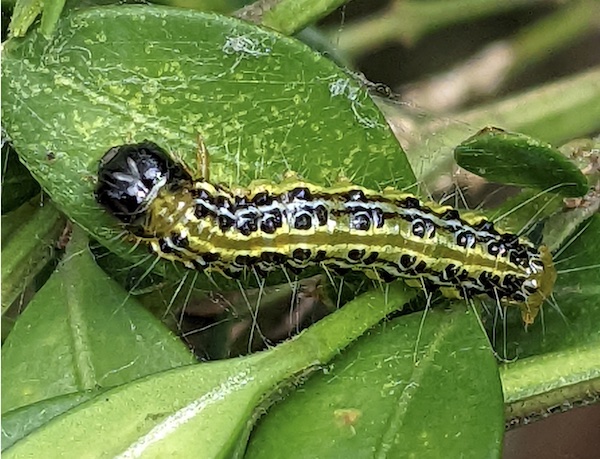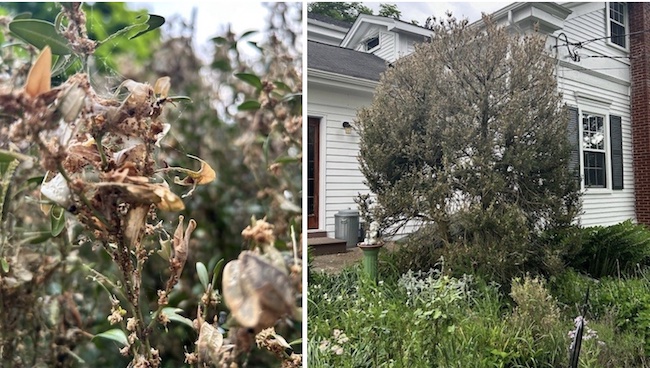Box Tree Moth wreaking havoc on boxwood plants in Orleans County

Photo by Elizabeth Buck: A Box Tree Moth Caterpillar is shown on a boxwood shrub.
Press Release, Katie Oakes, horticulture educator for Cornell Cooperative Extension in Orleans County
KNOWLESVILLE – Orleans County Cornell Cooperative Extension has received several calls in the last week reporting symptoms and damage from the exotic insect pest Box Tree Moth (Cydalima perspectalis).
Box Tree Moth (BTM) is most damaging during its caterpillar stage and it is active right now on boxwood plantings across the county. The caterpillar is a light green color with a black head and black and yellow markings along the body.
The young caterpillar hatches from eggs laid on the underside of boxwood leaves and then feeds on the bottoms of the leaves, often giving a light brown “peeled” look to the surface of the leaves.
As the caterpillars grow, they chew through entire leaves, sometimes leaving just the center vein of the leaf in a narrow curled ribbon. Mature caterpillars create pockets of webbing as they prepare to pupate into the moth stage. Adult moths are either a light tan with darker brown border around the edges of their wings (typical), or completely dark brown (infrequently).
It is recommended to scout for this pest now if there are boxwoods present on your property. The best way to scout for BTM is to check deep within the dense branches of the boxwood and carefully inspect the undersides of the leaves.

Photos by Deb Roberts: (Left) There is evidence of BTM Caterpillar feeding damage, webbing and frass (excrement). (Right) A boxwood tree has been severely defoliated by the Box Tree Moth Caterpillar.
If manageable numbers of BTM caterpillars are found, hand picking the caterpillars and dropping them into soapy water can be an effective management tool. Trimming individually affected branches and burning or bagging and disposing in municipal waste can also be effective.
If caterpillars are numerous or the boxwoods appear to be infested, there are pesticide options available by clicking the link within the NYS IPM Factsheet (Click here).
Homeowners may also choose to contact a certified pesticide applicator to help manage this pest. The International Society of Arboriculture website has a “Find an Arborist” tool that lets users search for certified arborists within their area (click here). Often, those arborists are certified as pesticide applicators as well and can help homeowners decide on next steps.
There are several other pests that can affect boxwoods such as Boxwood Leaf Miner, Boxwood Psyllid, Boxwood Blight among others, so proper scouting and identification of the issue is important before any treatment decisions are made. If you have questions about whether you are seeing Box Tree Moth or some other pest on your boxwood plantings, feel free to email questions or photos to Katie Oakes, Horticulture Educator at Orleans County CCE at klo54@cornell.edu.
Bringing a sample of the boxwood branch to the Orleans CCE office (12690 State Rt 31, Albion, NY) is also encouraged but because there is a federal quarantine on boxwoods because of the BTM pest. Any sample brought to the office would need to be bagged and sealed before transport.







































































